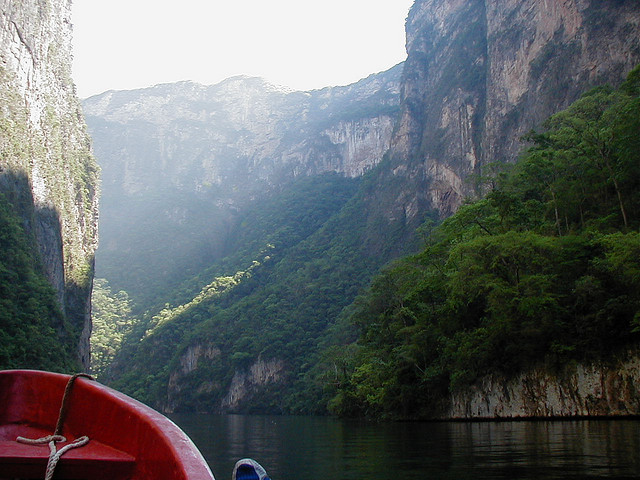
The Río Grijalva winds through Chiapas’s iconic Cañón del Sumidero, whose sheer limestone
walls are up to a thousand meters high and are graced by numerous wispy waterfalls. Photo © Jami Dwyer, licensed Creative Commons attribution Share-Alike.
The canyon was tens, even hundreds, of meters deeper before 1981 and the construction of the Chicoasén Dam, one of three presas on the mighty Río Grijalva. In Chiapa de Corzo, a painting in the Ex-Convento de Santo Domingo portrays an infamous story associated with the canyon: Early in the conquest, an indigenous community was invaded by Spanish troops. They fought fiercely, but could not defeat their better-armed opponents. Facing defeat, the indigenous men and women—many holding their children—leapt from the canyon walls to their deaths, rather than be captured.
Chiapa de Corzo is the main starting point for boat trips through Cañón del Sumidero. Boat tours (US$10 pp, 9 a.m.–4 p.m. daily) depart from the embarcadero at the end of Calle 5 de Febrero, downhill from the central plaza. Boats leave when they are full (12–16 people); afternoon trips are especially beautiful, but you’ll have less waiting time if you arrive between 9 a.m. and noon, especially in the low season.
The boat takes a little over an hour to reach the dam, with stops and explanations along the way, including at the canyon wall’s highest spot (1,000 m/0.6 mi) and various cave and rock formations, plus a beautiful mist-blown waterfall known as árbol de navidad (Christmas tree) for the lush triangle of moss and vegetation clinging to the wall beneath it.
You can also visit Cañón del Sumidero from above. Catch a trolley (US$7.50 pp, 9 a.m. and 1 p.m. Sat.–Sun., daily during holidays) from Parque Marimba in Tuxtla Gutiérrez for a three-hour trip along the western rim of the canyon, stopping at five miradores (lookout points) for stomach-lurching views of the canyon and river below. You can also drive the route yourself; it’s part of the national park, so there’s an entrance fee of US$2 per car.
Parque Ecoturístico Cañón del Sumidero (tel. 961/602-8500, US$25–29 adult/child) is another of those “eco-parks” where visitors have a series of brief eco-ish encounters and spend the rest of the day reliving it by the pool and over seconds at the $12 buffet. Admission includes the standard boat trip through the canyon (the park is located just before the dam), but there are no return boats until 4:30 p.m.—you’re literally trapped there until then. Most activities, like kayaking, rappelling, and a five-station zip line, cost an additional fee (US$5–15); there are also hiking and biking trails and a small zoo.
Combis from Tuxtla Gutiérrez (US$1, 40 mins, 5 Calle Ote. Sur and 1 Av. Sur Pte.) leave every 10 minutes from 6 a.m. to 10 p.m. and drop you on the north side of Chiapa de Corzo’s central plaza. Catch return buses in the same place, on the opposite side of the street.
From San Cristóbal, take any Tuxtla-bound combi (US$3, 45 mins) from their stop on Carretera Panamericana at Avenida Insurgentes, near the ADO bus terminal. Combis from San Cristóbal don’t enter Chiapas de Corzo proper, so ask to be dropped at the first puente peatonal (foot bridge, a short distance after the toll booth); there, cross to the other side and catch a taxi (US$2.50) or colectivo into town (US$0.45). If you get dropped at the second foot bridge—some drivers seem to prefer stopping there—you can still cross and get a ride into town, it’s just a bit further. To return to San Cristóbal, catch a bus or taxi to the same spot, where San Cristóbal–bound colectivos pass frequently. However, they tend to be pretty full; if you’re a group of three or more, you may have better luck getting onto the same combi by backtracking to Tuxtla (just 15 minutes) and boarding a San Cristóbal combi at their point of origin.
Excerpted from the First Edition of Moon Chiapas.